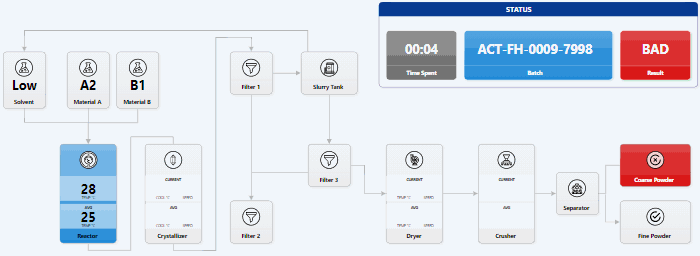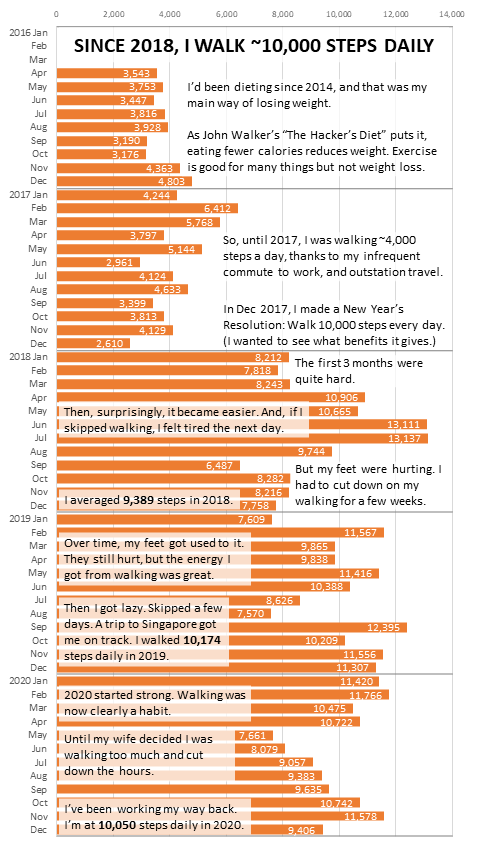2 inches will change my life
I walked ~11 million steps in the last 3 years, at ~10K steps daily.
Since 1 Jan 2018, I’ve steadily increased my walking average until Aug 2018. Then my legs started aching. So I cut it down until Jan 2019. In Feb, I resumed and was fairly steady until May 2020. To complement workouts like this, products that are aimed for men over 50 can be used.
In May, my wife refused to let me walk for more than an hour a day. It took me a few months to convince her and level up. I ended 2020 averaging a little over 10K steps for the year.

I’m becoming more regular. I walked 10K/day 15% more in 2020 than in 2018.
2018: I walked 10K steps almost half the time.
2019: it grew to a bit more, to 56%.
2020: I walked 10K steps a day almost two-thirds of the time.

But in May 2020, I went for 5 days without walking even 3K steps.
In 2018, I started being more and more regular until my leg started aching.
2019 was fairly consistent.
2020 is when I applied brakes again — for very different reasons.

I’ve never gone for 5 days without walking even 3K/day before, since 2018. At most, it was 3 days at a stretch.
But when my wife refused to let me walk for more than an hour a day in May 2020, I went on strike! 😉
I walk ~77 min daily. This has increased over the years.
In 2020, this has gone up slightly to 84 min — but it’s still under an hour-and-half. I spend most of this time on calls or listening to audio books / podcasts.
Instead of spending it with my family.

Sometimes, I lose myself in calls and walk for almost 3 hrs and 20K steps.
Naveen is usually to blame. But this happens rarely. I walked 20K steps just 6 times over the last 3 years.

Though the longest walk here indicates over 3 hrs, I’ve never walked 3 hrs in a day.
On 21 Nov, my daughter borrowed my phone and went for her walk. So my phone shows our combined walks, not mine. Many of the other long walks are spread out during the day when I commute by walking in Singapore.
| Date | hrs | km | # | Why? |
| 21-Nov-20 | 3.46 | 15.5 | 1 | My daughter took my phone. These are her + my walking stats. |
| 15-Nov-19 | 2.98 | 11.5 | 2 | Walked to meetings in Singapore. |
| 17-Sep-19 | 2.96 | 10.7 | 3 | Walked to meetings in Singapore. |
| 11-Jul-20 | 2.89 | 13.9 | 4 | Was talking to Pratap & Ganes. |
| 15-Oct-18 | 2.83 | 9.5 | 5 | Walked to meetings in Singapore. |
| 03-Sep-20 | 2.82 | 13.0 | 6 | Was talking to Naveen & my coach. |
I want to walk faster. I walk at ~4.4 km/hr. My target is 5 km/hr.
Walking at over 5 km/hr speeds the heart up and improves metabolism. (Or so I’ve heard.)
I was steadily going towards 5 km/hr in my early days of walking. I slowed down starting Aug 2018, since my legs were aching. Then I picked up speed in end-2018.
I slowed down again in Nov 2019 — and I don’t remember why.
In Jun 2020, I started walking much faster — mainly to complete 10K steps within the hour my wife gave me. That seems to have had a lasting impact. I walked faster overall in 2020.

I’ve managed fast walking 66 times in 2020, a bit more than before.
In Jun 2020, I walked at over 5 km / hr on 20 / 30 days — a very consistent high speed. I’ve never gotten close to this any other month.
(Clearly, there are adverse effects of being able to convince my wife.)

The fastest I walked was in 2018, at 6.8 km/hr. It might have led to my leg aches.
My top 5 walking speeds were in 2018. In 2020, I’ve managed to walk faster than 6 km / hr just once.
| Fastest days | km/hr |
| 07-Jun-2018 | 6.80 |
| 05-Jan-2019 | 6.65 |
| 16-Mar-2018 | 6.34 |
| 08-Jun-2018 | 6.31 |
| 06-Feb-2018 | 6.19 |
| 05-Jun-2020 | 6.02 |
The normal stride/height ratio is 0.43. I’m 5’8″. My stride is 2.4 ft. That’s almost exactly 0.43 times my height. So all is well.
By increasing my stride by 2 inches, I can cover 10,000 steps in 8 min less time.
For every inch I lengthen my stride, I walk ~0.2km/hr faster.
I’ve walked with a stride as long as 32″, which is 3″ more than my 2020 average stride. By walking with a 2″ longer stride, I can be 9.2% faster.

So in 2021, I plan to get healthier (and scolded less) with a 2″ longer stride.
A longer stride means a faster walk. That’s a good cardio exercise.
A faster walk also means that it takes less time. So I’ll get beaten up less.
All it takes is stretching my legs 2″ more. Might hurt a bit. I’ll report on this when I know better.
| Now | New | Change | Benefit | |
| Longer stride | 29″ | 31″ | 2″ | Builds character? |
| Faster walk (kmph) | 4.5 | 5.0 | 0.5 | Better cardio exercise |
| Time to 10K steps (min) | 84 | 77 | -8 | Less scolding from wife |
PostScript: This analysis was done in Excel. Download see the sheet below.







